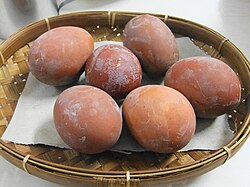 Unpeeled telur pindang, hard boiled eggs in spices Unpeeled telur pindang, hard boiled eggs in spices | |
| Place of origin | Indonesia |
|---|---|
| Region or state | Java and Sumatra |
| Associated cuisine | Indonesia, Malaysia and Singapore |
| Main ingredients | Eggs boiled in salt, soy sauce, shallot skins, and teak leaf |
Telur pindang or pindang eggs are hard-boiled eggs cooked in the pindang process, originating from Javanese cuisine, Indonesia, and popular in Malay as well as Palembang cuisine. The eggs are boiled slowly in water mixed with salt, soy sauce, shallot skins, teak leaf, and other spices. Due to its origins, it bears striking similarities with Chinese tea eggs. However, instead of black tea, this version uses leftover shallot skins, teak leaves or guava leaves as dark brownish coloring agents.
Terminology
The term pindang refers to the cooking process of boiling the ingredients in salt together with certain spices that contain tannin, usually soy sauce, shallot skin, guava leaves, teak leaves, tea, or other spices common in Southeast Asia. This gives the food a dark brown color and lasts longer compared to plainly boiled eggs, thus pindang is an Indonesian traditional method to preserve food, usually employed for fish and eggs. The technique is native to Java and Sumatra. Other preserving methods include asin or cured and dried in salt, and dendeng which is cured and dried in sugar, acar (pickling), and also asap (smoked).
Variations
Indonesia

Today, the telur pindang is widely spread throughout the Indonesian archipelago; however, it is found more prevalent in Javanese cuisine of Central and East Java, and also South Sumatra. Despite sharing similarities with Chinese tea eggs that employs tea leaves, this Indonesian version favours the use of teak leaves, guava leaves or spared shallots skin instead. The use of teak leaf as coloring agent might suggest its Javanese origin, since Java is famous for its teak wood for centuries. The teak leaf is also used to give reddish color in Yogyakarta's gudeg, or even as dyeing material in traditional Javanese batik-making. Indonesian cuisine favour the use of shallots than common onion, and subsequently the peeled shallot skins are usually collected and spared as key ingredient to make pindang eggs later.
The telur pindang is often served as part of tumpeng, nasi kuning or nasi campur. In Yogyakarta, telur pindang often served with gudeg or just steamed rice. It is also part of Chinese Indonesian lontong cap go meh. Those dishes, the tumpeng, nasi kuning, and lontong cap go meh, are important ceremonial dishes for each respective cultures, since eggs are traditionally symbolize fertility, regeneration and luck.
Malaysia

Telur pindang in Malaysia is most popular in Johor, the southernmost state in Peninsular Malaysia. The true origins of the dish are unclear; however, the cuisine most likely originated from Chinese merchants and settlers who came to the country in the 19th century through the once independent sultanate, having significant similarities to tea eggs.
Another possible theory suggests that it was probably brought by Javanese immigrants instead, that settled in Johor about a century ago. The recipe might have caught on due to its preserved nature. With Johor being a hub of international trade, it would be useful to the many merchants at sea who can benefit from such an easily stored food item that lasted for weeks.
The common ingredients of telur pindang are shallot skins, tamarind, fennel, coriander, soy sauce, and various leaves such as guava leaves or mangosteen leaves, although different recipes have different mixes of these ingredients or even additional ingredients, giving it a unique flavor. The notable difference between Malaysian and Indonesian telur pindang is the use of teak leaves, which are replaced with other leaves in most traditional Malaysian telur pindang recipes.
Telur pindang has a deep cultural heritage within Johorean, and in turn Malaysian, society. However, the daily use of telur pindang is now far more uncommon today due to its complicated and time-consuming method of cooking, restricted to mostly festivities or commercial sales. In turn, this creates an appreciation for the cuisine, regarded as an important part of Malay tradition.
See also
References
- ^ "Indonesian Marbled Hard Boiled Eggs or Telur Pindang". Food.com. Retrieved 12 March 2015.
- ^ "Pengolahan Jamur Komersial, Jahe Instan, Ikan Asap, Telur Pindang" (PDF) (in Indonesian). Jurusan Teknologi Pangan dan Gizi-IPB. pp. 103–104. Bogor. Archived from the original (PDF) on 2014-04-13.
- Prasetyo (2011). "Teknik Pengawetan Telur" (in Indonesian). Peternakan (Animal-Husbandry).
- "Membuat Telur Pindang yang Lezat dan Cantik" (in Indonesian). Bango. Archived from the original on 2 April 2015. Retrieved 12 March 2015.
- "Pindang Telur" (in Indonesian). Sajian Sedap.
- Deani Sekar Hapsari (26 November 2013). "Ulasan Khusus: Telur, Telur Pindang Bisa Dibuat dengan Langkah Mudah Ini" (in Indonesian). Detik Food.
- "Cerita di balik Lontong Cap Go Meh" (in Indonesian). Sajian Sedap. Retrieved 12 March 2015.
- Coope, A.E. (1936). "Journal of the Malayan Branch of the Royal Asiatic Society: The Kangchu System In Johore". Journal of the Malayan Branch of the Royal Asiatic Society. 14 (3 (126)). Johor: Malaysian Branch Of The Royal Asiatic Society: 247–263. JSTOR 41559862.
- Miyazaki, Koji. "Knowledge and Image across the Boundary: Javanese-Malay in Niche" (PDF). Research Institute for Languages and Cultures of Asia and Africa, Tokyo University of Foreign Studies.
- Hairul. "Telur Pindang Recipe For Weddings".
External links
- Indonesian Marbled Hard Boiled Eggs or Telur Pindang recipe (from Food.com)
- Telur pindang recipe (in Indonesian)